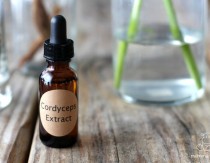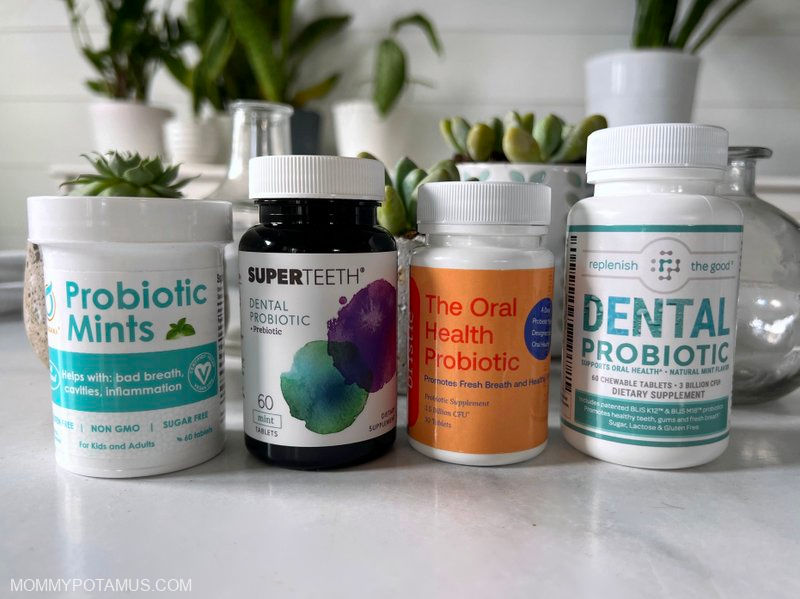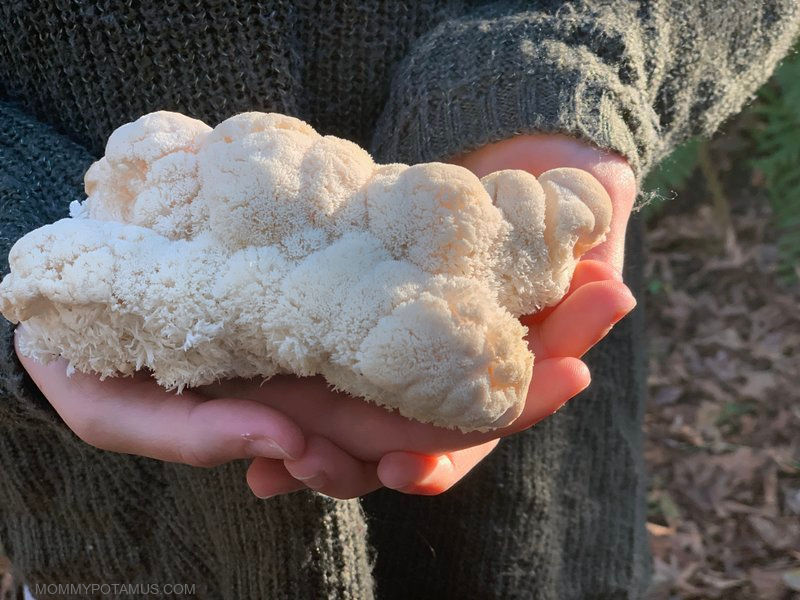
“So, guess what my mom is growing in our kitchen . . . ” << This was my son’s opening line for a presentation he recently gave, and since the subject of this article is healing mushrooms I’ll bet you can guess what he said: mushrooms!
Yep, lately I’ve been growing lion’s mane, reishi mushrooms that look like deer antlers and a wide variety of oyster mushrooms.
If I’ve accomplished nothing else as a parent, I have done enough weird things to give my kids tons of good stories for public speaking engagements, and social events.
Of course, I’m not growing mushrooms as conversation starters. Lion’s mane and a few other mushrooms are revered in Traditional Chinese Medicine (TCM) for their health benefits, and modern research has identified unique bioactive compounds that support their therapeutic use.
Before we dive into the research, I want to mention that none of these statements have been evaluated by the FDA, this article is not medical advice, and it is not meant to diagnose or treat any condition. Please talk with your healthcare provider about any herbs or dietary supplements you are considering.
- What is lion’s mane?
- 1. Supports Brain Health & Cognitive Function
- 2. Nervous System Support
- 3. Supports Immune Function
- 4. Supports Gut Health
- 5. Antioxidant Support
- 6. May Lift Mood & Increase Stress Resilience
- How To Use Lion’s Mane
- Does lion’s mane have any side effects?
- Have a question about lion’s mane?
- More Therapeutic Mushrooms To Try
- Want more research-backed natural remedies?
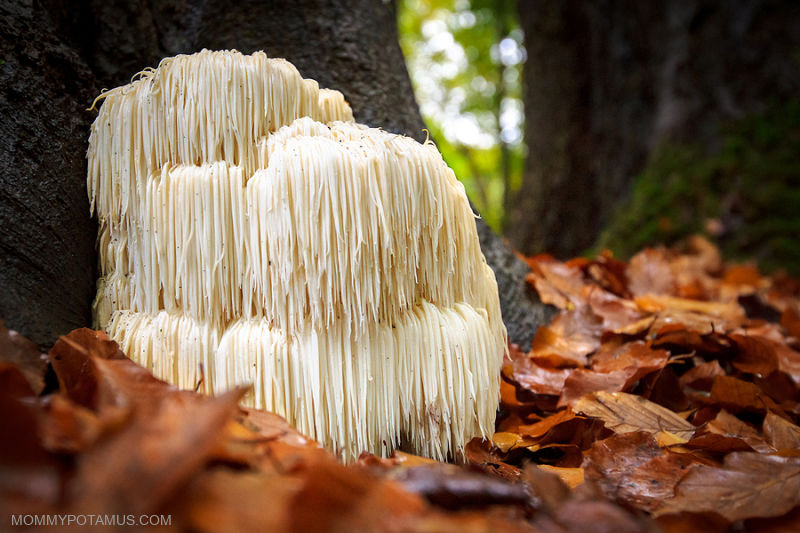
What is lion’s mane? ^
Also known as yamabushitake and the pom-pom mushroom, lion’s mane (Hericium erinaceus) gets its name from its unique appearance. Unlike most mushrooms – which have a smooth cap and stem – it develops cascading white strands that resemble a shaggy lion’s mane.
Found mostly in North America, China, Japan and Europe, lion’s mane grows out of decaying hardwood trees and is rich in several bioactive compounds that particularly benefit the brain, nervous system and gut:
- polysaccharides
- beta glucans
- hericenones
- erinacines
Here are six science-backed benefits:
1. Supports Brain Health & Cognitive Function ^
In Traditional Chinese Medicine (TCM), lion’s mane was often used for digestive issues and as a general restorative tonic due to its antioxidant and immune balancing properties. (1)
However, in the book Healing Mushrooms, Tero Isokauppila (the founder of Four Sigmatic) writes that it’s “lion’s mane’s effects on the brain that truly distinguish it from other medicinal mushrooms and make it an utterly fascinating subject.” (1)
That’s because as we age, our “neurons tend to accumulate impaired and aggregated proteins” which can impair cognitive function. (2)
Lion’s mane contains two compounds – hericenones and erinacines – that support the repair and regeneration of neurons, “resulting in improved overall cognitive function.” (1) (3)
It also supports the production of brain-derived neurotrophic factor (BDNF), which has been called “Miracle Gro for Your Brain.” (4) (5) (6)
BDNF is a “neurotrophin that supports the survival of existing neurons and encourages the growth and differentiation of new neurons and synapses.” (7)
Research shows that intense exercise, sun exposure, intermittent fasting, sulforaphane and the activation of heat shock proteins (like those created when sitting in an infrared sauna) all increase BDNF as well. (8) (9) (10) (11) (12)
In one small study done with Japanese adults between the age of 50-80, the Lion’s Mane mushroom group “showed increased scores on the cognitive function scale compared with the placebo group.” (13)
2. Nervous System Support ^
You know those two bioactive compounds we just covered? They can do some pretty amazing things for our nervous system, too.
Here’s how Tero explains it:
Your body contains nerve growth factor (NGF) proteins, which protect existing neurons and stimulate new neuron growth. These proteins play a crucial role in maintaining the viability of the neurons required for the nervous system to function properly. However, an issue arises when we consider the blood-brain barrier, an internal filtering system whose purpose is to protect the central nervous system by filtering out foreign compounds before they enter the brain. At the same time, the blood-barrier is not permeable by NGF proteins, which are too big to pass through. If your brain is making enough NGF, then all is fine. However, if it’s not, the neurons in your brain will not survive and new neurons won’t be produced. ” (1)
He adds that lion’s mane supports the synthesis of NGF:
How? Let’s go back to its Latin name, Hericium erinaceus. Hericenones are the molecular compounds that stimulate the brain to make more NGF. Erinacines are even more powerful compounds that are small enough to permeate the blood-brain barrier. Together, these compounds can foster NGF production from within the brain. It’s pretty astonishing.” (1)
NGF and BDNF also help our bodies make myelin, which is the protective coating around nerve cells that helps them quickly send information to our brain. (14) (15)
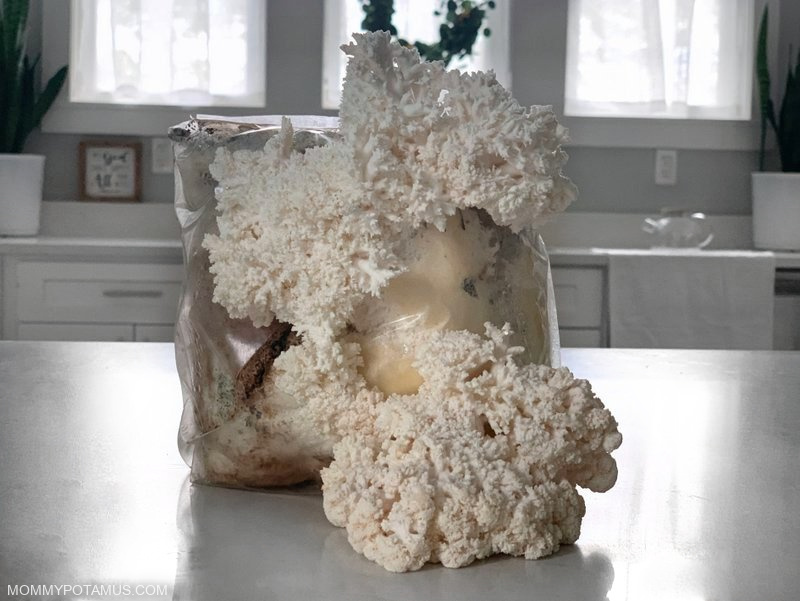
3. Supports Immune Function ^
Lion’s mande is rich in beta-glucans, a type of polysaccharide, plus other compounds that are believed to work synergistically with the immune system.
In Medicinal Mushrooms: A Clinical Guide, Martin Powell writes:
Polysaccharides are not the sole category of therapeutically active compound present in mushrooms but they are the most widespread, and, in many but not all mushrooms, the most important with a profound impact in the immune system mediated by a number of fungal polysaccharide-specific receptors on the surface of several classes of immune cell.”
In other words, our cells have receptors that are specifically designed to work with the kinds of polysaccharides generated by mushrooms, leading Power to wonder if they might be “essential nutrients for our immune system.”
In addition to their immune supporting benefits, polysaccharides such as beta-glucans also:
- Support autophagy (Taking out the cellular trash) (16)
- Support healthy blood pressure (1)
- Encourage healthy blood sugar levels (1)
- Help optimize cholesterol levels (1)
4. Supports Gut Health ^
In addition to the benefits above, polysaccharides also have a prebiotic effect that supports gut health. (17) Research suggests they may soothe gut inflammation – which is helpful for both nutrient absorption – while also supporting immune function in a couple of different ways. (18)
Yep, though we’ve already talked about the benefits of lion’s mane for immune health, it’s worth noting that it’s impact on gut health also supports immune function by:
- Nourishing microbiome diversity – Unlike probiotics, which are beneficial bacteria that we take internally through supplementation or fermented foods, prebiotics such as polysaccharides feed good bacteria and increase microbiome diversity. (19)
- Supporting innate immunity – The barriers that keep harmful materials from entering our bloodstream and other parts of our body” are part of our body’s innate immune system. Lion’s mane helps regulate “intestinal mucosal immune activity,” which optimizes our gut barrier.(20)
5. Antioxidant Support ^
Our bodies break down toxins via oxidation – a process that transforms them into water-soluble compounds that can be flushed out of the body. Oxidation produces free radicals, which can damage tissues and accelerate aging unless they are neutralized by antioxidants.
Lion’s mane mushrooms provide antioxidant support in two ways by:
- Directly supplying the body with potent antioxidants (21) (22)
- Serving as a bioactivator of the Nrf2 pathway, which encourages the production of the body’s master antioxidant: glutathione (23) (24)
6. May Lift Mood & Increase Stress Resilience ^
The cognitive benefits of lion’s mane may help lift mood, too. (25) (26)
In animal studies, lion’s mane demonstrated a positive impact on neuron production in the hippocampus, which is the part of the brain that regulates emotions. (27)
In one study involving cookies – which is of course the best kind of study – women who ate cookies containing lion’s mane reported a significant improvement in mood over women who ate placebo cookies. (28)
Lion’s mane is also known as an adaptogen, or substance that helps our bodies adapt to stress.
How To Use Lion’s Mane ^
There are several effective ways to consume lion’s mane, but there are a couple things you need to know first:
While all parts of the mushroom play an important role in nature, the fruiting body is what delivers nutrients and healing benefits directly to humans. The fruiting body is what humans and animals have always eaten, as it’s what is naturally available. As you begin researching different mushroom products, you’ll notice that many of them are mycelium-based. [Mycelium are thin filaments similar to roots.] These are less effective in terms of delivering health benefits than those that are fruiting-body-based, as the fruiting bodies can be extracted and concentrated much more readily than mycelium can.” (1)
Also, it’s important to consider the extraction method. Water extracts valuable polysaccharides, while alcohol extracts other beneficial compounds. Generally, the best products are dual extraction, which means they use both methods together.
With that in mind, here are some of the best ways to take lion’s mane:
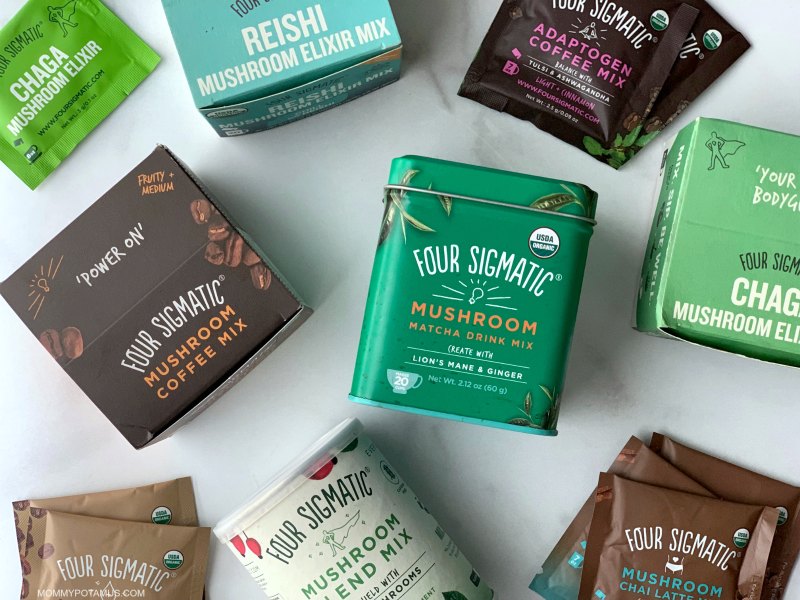
Drink it in your coffee or tea
Not surprisingly, as the founder of Four Sigmatic, Tero has created several delicious ways to get the benefits of lion’s mane. Use coupon code MP15 to save 15%.
Lion’s Mane Elixir (Caffeine-free) – This dual-extracted powdered blend of organic lion’s mane, organic rhodiola, and organic rosehips and mint can be mixed with hot water, coffee, or herbal tea.
Ground Mushroom Coffee With Lion’s Mane – Made with organic, fair trade Arabica coffee beans, this coffee comes with a blend of lion’s mane and another highly-prized mushroom, chaga.
Instant Mushroom Coffee With Lion’s Mane, Chaga and Rhodiola – I often keep this dual extracted powdered coffee in my bag for coffee emergencies.
Matcha Latte With Lion’s Mane – If you’re more of a matcha person, this dual extracted powder with moringa is the way to go.
Take it as a supplement
Lion’s Mane Capsules from Real Mushrooms – This is what I’m currently taking. It’s made from the fruiting bodies instead of the mycelium and it doesn’t include unnecessary fillers. I met the owner a few years ago and we talked about mushrooms for over an hour. He’s incredibly knowledgeable and truly cares about quality and potency.
Lion’s Mane Powder from Real Mushrooms – If you want a powdered option to add to smoothies, this is the way to go.
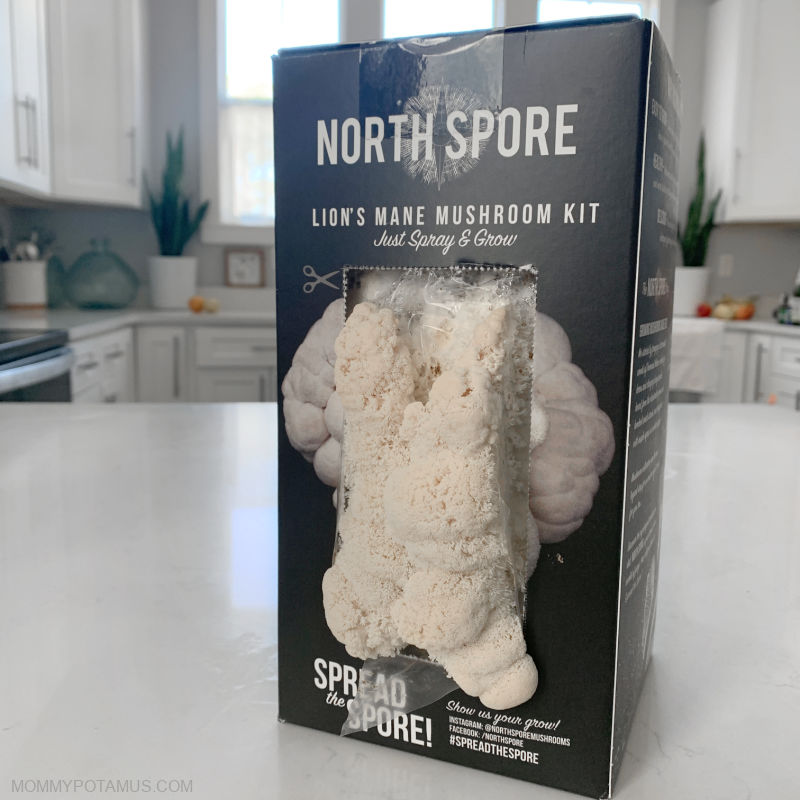
Grow it on your kitchen counter!
Lion’s mane mushrooms have a meaty, almost crab-like flavor that is delicious when sauteed in butter. Although fresh lion’s mane is not a potent and concentrated extracts, it’s still beneficial and totally delicious. Plus, it’s a great way to get kids interested in healing mushrooms.
I’ve grown mushrooms in a lot of different ways over the years – on coffee grounds, outdoor logs and more. This fall North Spore sent me some Spray & Grow Kits to test and they are the absolute easiest and most consistent way to grow lion’s mane and oyster mushrooms that I’ve found. I highly recommend them!
Does lion’s mane have any side effects? ^
In Healing Mushrooms, Tero writes that “unlike most medicines used for cognitive function – prescribed or holistic – there are no known side effects to lion’s mane. It can be taken every day (in capsule form or as a powder dissolved in liquid . . . without risk of adverse consequences” if the dosage he suggests is followed. (1)
That dosage (by weight) is:
- Dual extraction products – 0.5 grams is good, 1 gram is better, 1.5 grams is best
- Hot water extraction products = 1 gram is good, 2 grams is better, 3 grams is best
- Dried mushrooms – 10 grams is good, 20 grams is better, 30 grams is best
- Fresh mushrooms – 90 grams is good, 180 grams is better, 270 grams is best
However, there are some things to keep in mind:
- The above recommendations are rough estimates for daily use in adults
- Lion’s mane benefits are best achieved when it’s taken daily over a period of time (weeks to months)
- While these mushrooms are generally regarded as safe by health professionals, if you are pregnant or taking prescription medications, consult with your doctor before consuming them.
- One case of respiratory distress has been reported in someone who took lion’s mane for several months, likely due to an allergic reaction. Anyone who is allergic or sensitive to mushrooms should avoid lion’s mane. (29)
Have a question about lion’s mane? ^
Please let me know in the comments below?
More Therapeutic Mushrooms To Try ^
Chaga – Sometimes called the “King of Mushrooms” or “Black Gold,” chaga has been used for thousands of years to support immune function, relieve stress, and nourish skin from the inside out. Just one cup of chaga tea packs the same number of antioxidants as thirty pounds of carrots.
Reishi – Sometimes referred to as the “Mushroom of Immortality,” reishi has traditionally been used to promote longevity, support immune function, increase stress resilience, improve mental clarity and more.
It’s rare to find in the wild, and for thousands of years was mostly reserved for the Chinese emperor and his court. Fortunately for us, it can now be cultivated and is widely available.
Cordyceps – Found in the foothills of the Himalaya mountains in Tibet and Bhutan, the cordyceps mushroom has a long history of use in Traditional Chinese Medicine.
According to Donald Yance, clinical herbalist and author of Adaptogens in Medical Herbalism, “It is considered to be one of the most valuable . . . herbs used traditionally in China, equaling ginseng as a restorative tonic.”
Want more research-backed natural remedies? ^
No problem, I’ve created a free ebook for you – Kitchen Apothecary: 25+ Natural Remedies Using Ingredients From Your Pantry – as a gift for signing up for my newsletter. You’ll also get updates when I post about safe essential oils for pregnant/breastfeeding mamas, exclusive gifts and coupons (I was able to give away a jar of free coconut oil to anyone who wanted it recently!), plus other goodies.
Sign up using the form below.
Sources
1. Isokauppila, Tero (2017) Healing Mushrooms
2. Castelli, Vanessa et. al. (2019) Neuronal Cells Rearrangement During Aging and Neurodegenerative Disease: Metabolism, Oxidative Stress and Organelles Dynamic
3. Lai, Puei-Lene et. al. (2013) Neurotrophic properties of the Lion’s mane medicinal mushroom, Hericium erinaceus (Higher Basidiomycetes) from Malaysia
4. Ryu, Se Hwan et. al. (2021) Neurotrophic isoindolinones from the fruiting bodies of Hericium erinaceus
5. Vigna, Luisella et. al. (2019) Hericium erinaceus Improves Mood and Sleep Disorders in Patients Affected by Overweight or Obesity: Could Circulating Pro-BDNF and BDNF Be Potential Biomarkers?
6. Bergland, Christopher (2016) This Is Why Aerobic Exercise Is ‘Miracle-Gro’ for Your Brain
7. Kim, Jisung et al (2016) Sulforaphane epigenetically enhances neuronal BDNF expression and TrkB signaling pathways
8. Sleiman, Sama et. al. (2016) Exercise promotes the expression of brain derived neurotrophic factor (BDNF) through the action of the ketone body β-hydroxybutyrate
9. De la Rosa, Adrian (2019) Long-term exercise training improves memory in middle-aged men and modulates peripheral levels of BDNF and Cathepsin B
10. Molendijk, Marc et. al. (2012) Serum BDNF Concentrations Show Strong Seasonal Variation and Correlations with the Amount of Ambient Sunlight
11. Mattson, Mark (2005) Energy intake, meal frequency, and health: a neurobiological perspective
12. Piepmeier, Aaron (2014) Brain-derived neurotrophic factor (BDNF) as a potential mechanism of the effects of acute exercise on cognitive performance
13. Koichiro Mori et al. (2008) Improving Effects of the Mushroom Yamabushitake (Hericium erinaceus) on Mild Cognitive Impairment: A Double‐Blind Placebo‐Controlled Clinical Trial
14. Tolwani, Ravi J et. al. (2004) BDNF overexpression produces a long-term increase in myelin formation in the peripheral nervous system
15. Xiao, Junhua et. al. (2009) The Role of Neurotrophins in the Regulation of Myelin Development
16. Pan, Haito et. al. (2019) Autophagic flux disruption contributes to Ganoderma lucidum polysaccharide-induced apoptosis in human colorectal cancer cells via MARK/ERK activation
17. Jayachandran, Muthukumaran et. al. (2017) A Critical Review on Health Promoting Benefits of Edible Mushrooms through Gut Microbiota
18. Li, Cailan et. al. (2021) Natural-Derived Polysaccharides From Plants, Mushrooms, and Seaweeds for the Treatment of Inflammatory Bowel Disease
19. Diling, Chen (2017) Immunomodulatory Activities of a Fungal Protein Extracted from Hericium erinaceus through Regulating the Gut Microbiota
20. Sheng, Xiaotong et al. (2017) Immunomodulatory Effects of Hericium erinaceus Derived Polysaccharides are Mediated by Intestinal Immunology
21. Abdullah, Noorlidah (2011) Evaluation of Selected Culinary-Medicinal Mushrooms for Antioxidant and ACE Inhibitory Activities
22. Hou, Yiling et. al. (2015) Composition and antioxidant activity of water-soluble oligosaccharides from Hericium erinaceus
23. Vargas-Mendoza, Nancy et. al. (2020) Flavolignans from Silymarin as Nrf2 Bioactivators and Their Therapeutic Applications
24. Thomas Easley and Steven Horne (2016) The Modern Herbal Dispensatory
25. Yao, Wei et. al. (2015) Effects of amycenone on serum levels of tumor necrosis factor-α, interleukin-10, and depression-like behavior in mice after lipopolysaccharide administration
26. Chiu, Chun-Hung et. al. (2018) Erinacine A-Enriched Hericium erinaceus Mycelium Produces Antidepressant-Like Effects through Modulating BDNF/PI3K/Akt/GSK-3β Signaling in Mice
27. Ryu, Sun et. al. (2018) Hericium erinaceus Extract Reduces Anxiety and Depressive Behaviors by Promoting Hippocampal Neurogenesis in the Adult Mouse Brain
28. Nagano, Mayumi (2010) Reduction of depression and anxiety by 4 weeks Hericium erinaceus intake
29. Nakatsugawa, Munehide et. al. (2003) Hericium erinaceum (yamabushitake) extract-induced acute respiratory distress syndrome monitored by serum surfactant proteins

